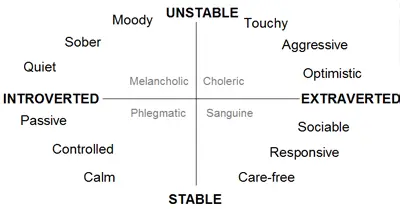Personality Definition: A personality is a mixture of a person’s characteristics, beliefs and qualities which make them who they are.
The following is information to help predict how a person will act within a job and what abilities they need to be a good employee.
- Conscientiousness: Some argue this is a valid predictor of performance. But negatively correlated with creativity. Conscientiousness is how you act around people, how careful you are with people and your work. It’s about self-discipline, carefulness and thoroughness.
- Emotional Stability: Has been said that it is positively associated with job performance. Emotional stability refers to whether you cope with situations, not bringing problems to work and letting them affect your performance.
- Extraversion: This has been found to correlate positively with performance in jobs such as sales, because people find it easier to interact with potential customers.
- Agreeableness: Positively correlates with job performance because it indicates that you get on with people better. However, for people in higher positions this is normally lower, due to them having to stick up, put there point across.
Contents
Catell’s 16 Personality Factors
There are also a few more in-depth theories to how people will do in jobs based on their personality. One which is still used widely today, even though it is getting older, is Catell’s 16 personality factors:
- Reserved v warm
- Concrete reasoning v abstract reasoning
- Reactive v emotionally stable
- Deferential v dominant
- Serious v lively
- Expedient v rule-conscious
- Shy v socially bold
- Utilitarian v sensitive
- Trusting v vigilant
- Practical v imaginative
- Forthright v private
- Self-assured v apprehensive
- Traditional v open-to-change
- Group-oriented v self-reliant
- Tolerates disorder v perfectionist
- Relaxed v tense
Eysenk’s 2 Dimensions of Personality
Extroverts
Stimulated by the outside work, the environment, consisting of other people and things. Below are some words to describe extroverts;
- Active
- Outward
- Sociable
- People
- Expressive
Introverts
Stimulated by themselves, from within, from thoughts about themselves and reflections of the past. below are some words to describe an introvert;
- Reflective
- Reserved
- Privacy
- Quiet

After thinking of the above diagram, Eysenk came up with a third dimension, this was called Psychoticism. This meant that his theory now had three dimensions; Psychoticism, Extraversion, and Neuroticism
Big Five Model (Costa and McRae, 1970’s)
The big five, also known as OCEAN, which will be explained later, describes main personality traits which are seen in people. Each dimension has an idea of what kind of people will fit in with each side of that dimension. Those in the middle of each of the dimensions are usually people who can move from one side to the other with ease, although in some cases this can be a problem because someone may be needed who always stick to their side. Below are each of the dimensions explained:
- O – Openness – Artistically sensitive, intellectual, interests, reflective, insightful, curious.
- C – Conscientiousness – Efficient, reliable, responsible, ethical, organised, self-disciplined, scrupulous.
- E – Extroversion – Talkative, outgoing, candid, energetic, adventurous, sociable, assertive.
- A – Agreeableness – Good-natured, forgiving, generous, non-critical, warm, cooperative, trusting.
- N – Neuroticism – Anxious, tense, hostile, excitable, emotionally unstable, impulsive.
Key Learning Points
- What is the Definition of Personality?
- What are the Four Personality Predictors?
- What are the 16 Personality Factors?
- What are the 2 Dimensions of Personality?
- Explain the Big Five Model?
